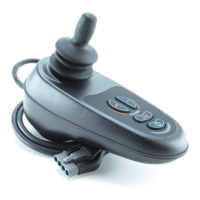VR2 CONTROL SYSTEM
SK77898/2
PG DRIVES TECHNOLOGY
38
10 Actuator Control
The VR2 control system has the facility for 2 actuator output channels. Each actuator
channel can supply a maximum current of 12A. The VR2 provides automatic end-
stop detection for each actuator, see section 10.1.
To ensure correct operation of the user controls for 1 or 2 actuator applications, it is
necessary to program the control system accordingly. The parameter for adjustment
is Number of Actuators. Refer to Chapter 3 for details of programming.
10.1 Actuator End-stop Detection
The VR2 continuously monitors the actuator drive current so that when the actuator
reaches the end of its travel the rise in current is detected and the power to the
actuator is automatically shut off. When the actuator current reaches the programmed
End Force for a period of time greater than the programmed Actuator Current Limit
Timeout the actuator is stopped.
Because of the wide variation in actuator motors and applications, the end-stop
current threshold is programmable.
The parameters for adjustment are:
Actuator 1: Actuator Current Limit Timeout
Actuator 2: Actuator Current Limit Timeout
Actuator 1: End Force
Actuator 2: End Force
Actuator Current Limit Timeout is programmable between 0 and 500 in steps of
10ms.
Actuator End Force is programmable between 1 and 5 in steps of 1.
The values should be chosen so that the actuator can move under its heaviest load
condition, but will shut off automatically and consistently when stalled at the end
stop.
When the actuator end stop is reached an audible feedback can be programmed.
The associated parameter is Actuator End Stop Bleep. Refer to Chapter 3 for
programming details.
10.2 Actuator Inhibits
The Inhibits inputs can be used to inhibit the movement range of the actuator
channels. You can limit the amount of movement for either actuator channel in
either direction by programming Inhibit Bands 0 and or 3.
Refer to chapter 3 for programming details
10.3 Actuator Motors
The VR2 control system is designed to be connected to permanent magnet DC
actuator motors. The VR2 may not be compatible with actuators that have their
own over-current detection electronics. Actuator assemblies with slipping clutches
may also be unsuitable as the motors will never stall, therefore, not allowing the

